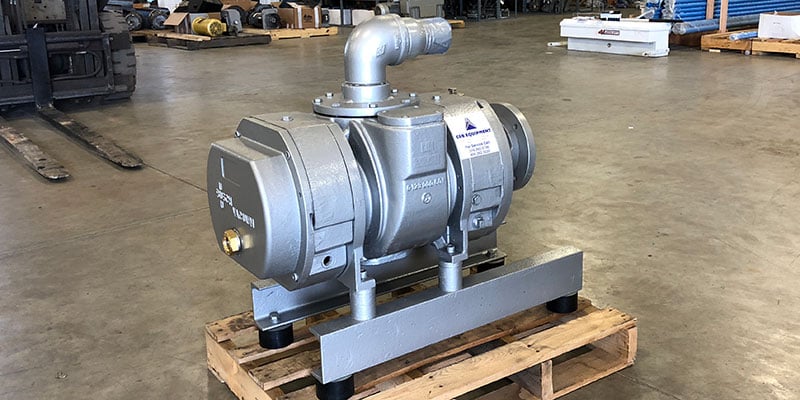The Impact of Choosing the Right Vacuum Pump for Fly Ash Suction in Power Plants
In the power generation industry, the management of fly ash is a crucial aspect that significantly affects the overall efficiency, safety, and environmental impact of a plant. Fly ash, a byproduct of burning pulverised coal in power plants, needs to be efficiently removed and transported to maintain a safe and clean environment. To accomplish this, the utilisation of vacuum pumps for dry suction work is essential. With the vast range of vacuum pump technology available on the market, selecting the right pump for fly ash suction can be the determining factor between a “can do” and a “can’t do” scenario for a plant’s operational success. This blog will delve into the key considerations for selecting the correct vacuum pump for fly ash suction in power plants and the benefits it provides to productivity, safety, and economic factors.
Choosing the right vacuum pump is vital for various reasons. First and foremost, the capability of the pump to handle the challenging environment of fly ash transportation is of paramount importance. The build-up of fly ash within the vacuum pump system can lead to decreased efficiency, equipment damage, and even hazardous conditions. An appropriate vacuum pump must be designed to minimise, if not eliminate, the risk of fly ash settling, resulting in consistent operation without frequent downtime for maintenance. Additionally, the pump must provide the required suction power and flow capacity to handle the volume of fly ash produced by the plant.
Energy efficiency is another critical factor to consider while selecting a vacuum pump for fly ash suction. With increasing global emphasis on reducing power consumption and greenhouse gas emissions, plants are continually seeking ways to maximise energy efficiency. Choosing a vacuum pump with high energy efficiency can significantly contribute to reducing a plant’s overall carbon footprint.
Finally, the economic impact of selecting the right vacuum pump cannot be understated. Initial capital expenditure, operational costs, maintenance, and the potential for process downtime all play a role in determining the most cost-effective solution. In this blog, TEGS Thailand will examine various vacuum pump options available in the market, compare their performance, energy efficiency, and costs, and conclude with a guide to help power plants make the right choice for their fly ash suction needs.
The Importance of Choosing the Right Vacuum Pump for Fly Ash Suction
The mechanical elements involved in the removal and transportation of fly ash in power plants comprise an essential aspect of ensuring operational efficiency and safety. One of the critical components in this process is the vacuum pump, responsible for suctioning the fly ash and preventing potential hazards resulting from the byproduct’s accumulation. By carefully selecting the correct vacuum pump for fly ash suction, power plants can take advantage of significant benefits in terms of productivity, safety, and environmental responsibility.
Understanding Fly Ash and Its Challenges
Fly ash is a fine, powdery byproduct produced by burning pulverised coal in power plants. Comprising mainly silicon dioxide, aluminium oxide, and iron oxide, fly ash exhibits a range of particle sizes, with larger particles being less of a concern. However, finer particles pose risks to environmental pollution and human respiratory health. Moreover, if left unmanaged, fly ash can accumulate, causing significant damage to equipment, impacting operational performance, and increasing the risk of accidents. Therefore, effective control and management of fly ash are crucial to a power plant’s safe and efficient operation.
The Role of Vacuum Pumps in Fly Ash Suction
Vacuum pumps are employed in power plants to remove fly ash from the area and transport it to collection systems or silos for disposal or further processing. Dry suction work, specifically, involves vacuum pumps designed to handle dry and dusty materials like fly ash without the need for water or lubrication. These vacuum pumps have two primary roles in this context – to create the suction effect within a piping network and to ensure an efficient flow of fly ash while maintaining the desired vacuum level.
Vacuum Pump Types and their Suitability for Fly Ash Suction
Various vacuum pump technologies are available to address the specific requirements of fly ash suction in power plants, including rotary vane pumps, liquid ring pumps, and positive displacement blowers. Each of these technologies has its advantages and limitations in the context of fly ash suction applications.
1. Rotary Vane Pumps
Rotary vane pumps are widely used for various industrial applications due to their simple operating principle, compactness, and cost-effectiveness. The pump’s operational mechanism allows for the creation of a strong vacuum suitable for effectively removing fly ash. However, this type of vacuum pump may not be ideal for fly ash applications due to its sensitivity to dust and potential risk of wear and tear. Additionally, rotary vane pumps may require oil lubrication, which can introduce unwanted contamination into the fly ash stream and negatively impact the plant’s ability to recycle or repurpose the material.
2. Liquid Ring Pumps
Liquid ring vacuum pumps are another common choice for fly ash suction applications. These pumps function by creating a liquid ring within the pump casing, which results in a robust vacuum. Liquid ring pumps offer the advantage of better dust handling capabilities due to their inherent liquid sealing mechanism, making them more suitable for fly ash suction. However, the energy consumption of liquid ring pumps is generally higher than that of other pump types, and water is often required as the sealing fluid, adding an extra dimension to process management.
3. Positive Displacement Blowers
Positive displacement blowers, or root blowers, are often preferred for fly ash suction applications in power plants, thanks to their ability to handle large volumes of air and solids without the need for a liquid sealant. These blowers work by trapping a fixed volume of air and then displacing it, creating a vacuum that effectively transports the fly ash through the piping system. As positive displacement blowers are designed to handle dusty materials, they are tolerant of abrasive fly ash and offer reliable performance with minimal degradation. While these blowers may have a higher initial capital expenditure, their operational and maintenance costs are generally lower than other vacuum pump options.
Selecting the Ideal Vacuum Pump: Key Considerations
When evaluating vacuum pump options for fly ash suction, power plants need to consider factors such as energy efficiency, handling capabilities, maintenance requirements, and cost. In general, positive displacement blowers emerge as the preferred choice for this application. However, it is crucial to consult industry experts or experienced professionals to determine the optimal vacuum pump solution based on the specific requirements and constraints of a particular plant.
Conclusion
Selecting the right vacuum pump for fly ash suction in power plants is a critical decision with far-reaching implications on efficiency, safety, and environmental impact. By carefully considering factors like handling capabilities, energy consumption, and operational/maintenance costs, power plants can make informed choices that protect productivity and bolster their environmental and social responsibility.
Whenever you need a high-performance vacuum and a team of professional industrial cleaners, look no further than TEGS Thailand. Reach out to us today to get started!




